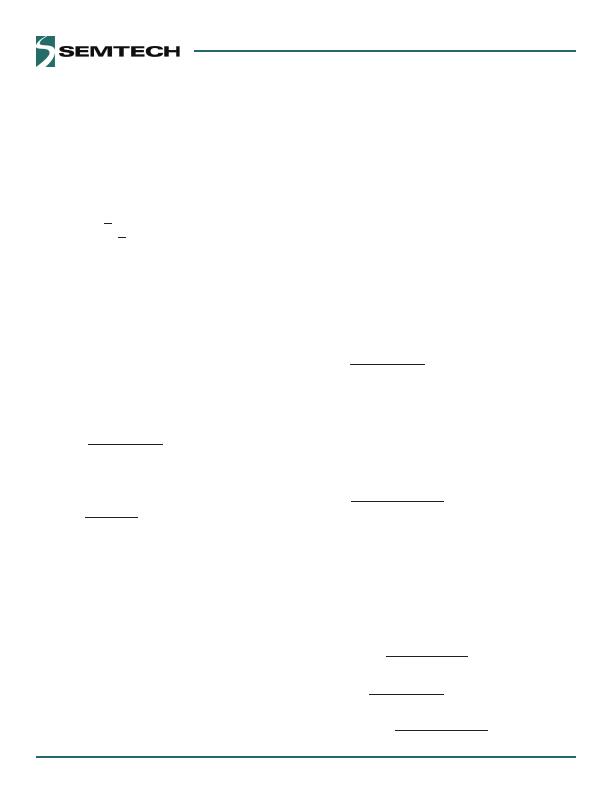- 您現在的位置:買賣IC網 > Datasheet目錄46 > SC418ULTRT (Semtech)IC REG DL BUCK/LINEAR 20MLPQ Datasheet資料下載
參數資料
| 型號: | SC418ULTRT |
| 廠商: | Semtech |
| 文件頁數: | 22/30頁 |
| 文件大小: | 691K |
| 描述: | IC REG DL BUCK/LINEAR 20MLPQ |
| 產品培訓模塊: | Power Supplies 101 |
| 標準包裝: | 1 |
| 系列: | EcoSpeed® |
| 拓撲: | 降壓(降壓)(1),線性(LDO)(1) |
| 功能: | 任何功能 |
| 輸出數: | 2 |
| 頻率 - 開關: | 1MHz |
| 電壓/電流 - 輸出 1: | 控制器 |
| 電壓/電流 - 輸出 2: | 0.75 V ~ 5.25 V,200mA |
| 帶 LED 驅動器: | 無 |
| 帶監控器: | 無 |
| 帶序列發生器: | 無 |
| 電源電壓: | 3 V ~ 28 V |
| 工作溫度: | -40°C ~ 85°C |
| 安裝類型: | 表面貼裝 |
| 封裝/外殼: | 20-MLPQ |
| 供應商設備封裝: | 20-MLPQ(3x3) |
| 包裝: | 標準包裝 |
| 其它名稱: | SC418ULTRTDKR |
第1頁第2頁第3頁第4頁第5頁第6頁第7頁第8頁第9頁第10頁第11頁第12頁第13頁第14頁第15頁第16頁第17頁第18頁第19頁第20頁第21頁當前第22頁第23頁第24頁第25頁第26頁第27頁第28頁第29頁第30頁

SC418
22
Applications Information (continued)
load current relates to thermal stresses which drive the
selection of the inductor and input capacitors. Peak load
current determines instantaneous component stresses and
fltering requirements such as inductor saturation, output
capacitors, and design of the current limit circuit.
The following values are used in this design.
V
IN
= 2V + 0%
V
OUT
= .05V + 4%
f
SW
= 250kHz
Load = 0A maximum
Frequency Selection
Selection of the switching frequency requires making a
trade-off between the size and cost of the external filter
components (inductor and output capacitor) and the
power conversion efficiency.
The desired switching frequency is 250kHz.
A resistor, R
TON
is used to program the on-time (indirectly
setting the frequency) using the following equation.
OUT
IN
ON
TON
V
pF
25
V
)
ns
10
T
(
R
To select R
TON
, use the maximum value for V
IN
, and for T
ON
use the value associated with maximum V
IN
.
SW
INMAX
OUT
ON
f
V
V
T
T
ON
= 318 ns at 13.2V
IN
, 1.05V
OUT
, 250kHz
Substituting for R
TON
results in the following solution.
R
TON
= 154.9k&, use R
TON
= 154k&
Inductor Selection
In order to determine the inductance, the ripple current
must first be defined. Low inductor values result in smaller
size but create higher ripple current which can reduce
efficiency. Higher inductor values will reduce the ripple
current/voltage and for a given DC resistance are more
efficient. However, larger inductance translates directly
into larger packages and higher cost. Cost, size, output
ripple, and efficiency are all used in the selection process.
"
"
"
"
The ripple current will also set the boundary for power-
save operation. The switching will typically enter power-
save mode when the load current decreases to /2 of the
ripple current. For example, if ripple current is 4A then
Power-save operation will typically start for loads less than
2A. If ripple current is set at 40% of maximum load current,
then power-save will start for loads less than 20% of
maximum current.
The inductor value is typically selected to provide a ripple
current that is between 25% to 50% of the maximum load
current. This provides an optimal trade-off between cost,
efficiency, and transient performance.
During the DH on-time, voltage across the inductor is
(V
IN
- V
OUT
). The following equation for determining induc-
tance is shown.
RIPPLE
ON
OUT
IN
I
T
)
V
V
(
L
In this example the inductor ripple current is set equal to
50% of the maximum load current. Thus ripple current
will be 50% x 0A or 5A.
To find the minimum inductance needed, use the V
IN
and
T
ON
values that correspond to V
INMAX
.
H
77
.
0
A
5
ns
318
)
05
.
1
2
.
13
(
L
A slightly larger value of 0.88礖 is selected. This will
decrease the maximum I
RIPPLE
to 4.4A.
Note that the inductor must be rated for the maximum DC
load current plus /2 of the ripple current.
The ripple current under minimum V
IN
conditions is also
checked using the following equations.
ns
384
ns
10
V
V
R
pF
25
T
INMIN
OUT
TON
VINMIN
_
ON
L
T
)
V
V
(
I
ON
OUT
IN
RIPPLE
A
25
.
4
H
088
ns
384
)
05
.
1
8
.
10
(
I
VINMIN
_
RIPPLE
相關PDF資料 |
PDF描述 |
|---|---|
| SC424MLTRT | IC REG DL BUCK/LINEAR 28MLPQ |
| SC4250LISTRT | IC HOT SWAP CTRLR 8-SOIC |
| SC427MLTRT | IC REG DL BUCK/LINEAR 32MLPQ |
| SE95D,112 | IC SENSOR TEMP 2.8-5.5V SOT96-1 |
| SE97BTP,547 | IC TEMP SENSOR DIMM 8HWSON |
相關代理商/技術參數 |
參數描述 |
|---|---|
| SC419 | 制造商:SEMTECH 制造商全稱:Semtech Corporation 功能描述:EcoSpeedTM DC-DC Converter with Integrated Boost Diode |
| SC419970CGCR2 | 制造商:Motorola Inc 功能描述: |
| SC419EVB | 制造商:SEMTECH 制造商全稱:Semtech Corporation 功能描述:EcoSpeedTM DC-DC Converter with Integrated Boost Diode |
| SC419ULTRT | 功能描述:IC REG CTRLR BUCK PWM 20-MLPQ RoHS:是 類別:集成電路 (IC) >> PMIC - 穩壓器 - DC DC 切換控制器 系列:EcoSpeed®, SmartDrive™ 特色產品:LM3753/54 Scalable 2-Phase Synchronous Buck Controllers 標準包裝:1 系列:PowerWise® PWM 型:電壓模式 輸出數:1 頻率 - 最大:1MHz 占空比:81% 電源電壓:4.5 V ~ 18 V 降壓:是 升壓:無 回掃:無 反相:無 倍增器:無 除法器:無 Cuk:無 隔離:無 工作溫度:-5°C ~ 125°C 封裝/外殼:32-WFQFN 裸露焊盤 包裝:Digi-Reel® 產品目錄頁面:1303 (CN2011-ZH PDF) 其它名稱:LM3754SQDKR |
| SC41E6 | 制造商:INFINEON 制造商全稱:Infineon Technologies AG 功能描述:SIEMENS ANNOUNCES A SUB-MICTON GENERATION OF CHANNELLESS GATE-ARRAYS BASED ON THE PROVEN MEGALOGIC PROCESS |
發布緊急采購,3分鐘左右您將得到回復。